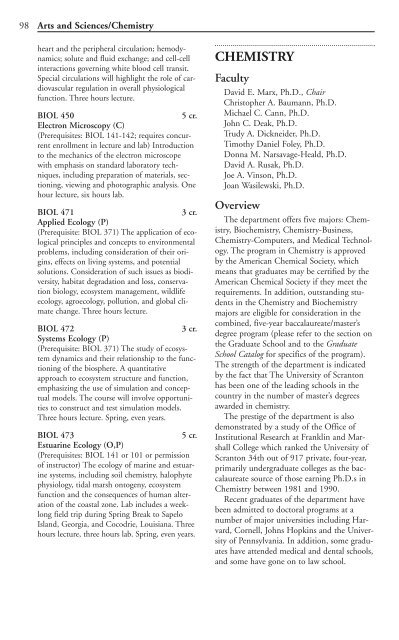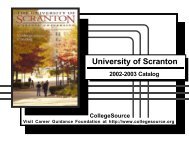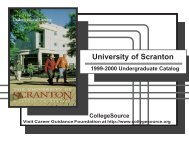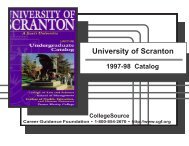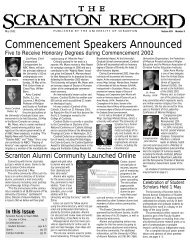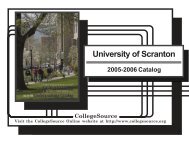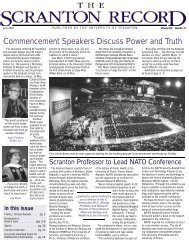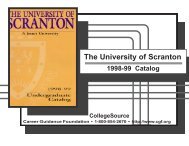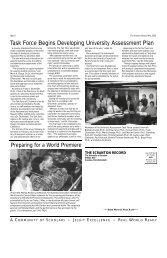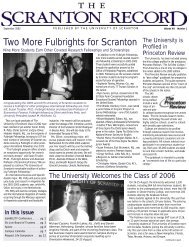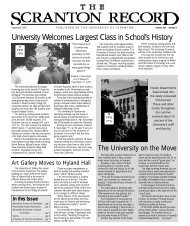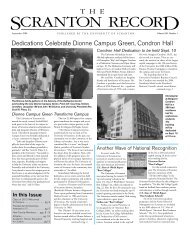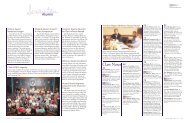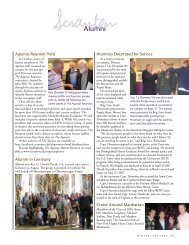2003-2004 - The University of Scranton
2003-2004 - The University of Scranton
2003-2004 - The University of Scranton
Create successful ePaper yourself
Turn your PDF publications into a flip-book with our unique Google optimized e-Paper software.
98 Arts and Sciences/Chemistry<br />
heart and the peripheral circulation; hemodynamics;<br />
solute and fluid exchange; and cell-cell<br />
interactions governing white blood cell transit.<br />
Special circulations will highlight the role <strong>of</strong> cardiovascular<br />
regulation in overall physiological<br />
function. Three hours lecture.<br />
BIOL 450 5 cr.<br />
Electron Microscopy (C)<br />
(Prerequisites: BIOL 141-142; requires concurrent<br />
enrollment in lecture and lab) Introduction<br />
to the mechanics <strong>of</strong> the electron microscope<br />
with emphasis on standard laboratory techniques,<br />
including preparation <strong>of</strong> materials, sectioning,<br />
viewing and photographic analysis. One<br />
hour lecture, six hours lab.<br />
BIOL 471 3 cr.<br />
Applied Ecology (P)<br />
(Prerequisite: BIOL 371) <strong>The</strong> application <strong>of</strong> ecological<br />
principles and concepts to environmental<br />
problems, including consideration <strong>of</strong> their origins,<br />
effects on living systems, and potential<br />
solutions. Consideration <strong>of</strong> such issues as biodiversity,<br />
habitat degradation and loss, conservation<br />
biology, ecosystem management, wildlife<br />
ecology, agroecology, pollution, and global climate<br />
change. Three hours lecture.<br />
BIOL 472 3 cr.<br />
Systems Ecology (P)<br />
(Prerequisite: BIOL 371) <strong>The</strong> study <strong>of</strong> ecosystem<br />
dynamics and their relationship to the functioning<br />
<strong>of</strong> the biosphere. A quantitative<br />
approach to ecosystem structure and function,<br />
emphasizing the use <strong>of</strong> simulation and conceptual<br />
models. <strong>The</strong> course will involve opportunities<br />
to construct and test simulation models.<br />
Three hours lecture. Spring, even years.<br />
BIOL 473 5 cr.<br />
Estuarine Ecology (O,P)<br />
(Prerequisites: BIOL 141 or 101 or permission<br />
<strong>of</strong> instructor) <strong>The</strong> ecology <strong>of</strong> marine and estuarine<br />
systems, including soil chemistry, halophyte<br />
physiology, tidal marsh ontogeny, ecosystem<br />
function and the consequences <strong>of</strong> human alteration<br />
<strong>of</strong> the coastal zone. Lab includes a weeklong<br />
field trip during Spring Break to Sapelo<br />
Island, Georgia, and Cocodrie, Louisiana. Three<br />
hours lecture, three hours lab. Spring, even years.<br />
CHEMISTRY<br />
Faculty<br />
David E. Marx, Ph.D., Chair<br />
Christopher A. Baumann, Ph.D.<br />
Michael C. Cann, Ph.D.<br />
John C. Deak, Ph.D.<br />
Trudy A. Dickneider, Ph.D.<br />
Timothy Daniel Foley, Ph.D.<br />
Donna M. Narsavage-Heald, Ph.D.<br />
David A. Rusak, Ph.D.<br />
Joe A. Vinson, Ph.D.<br />
Joan Wasilewski, Ph.D.<br />
Overview<br />
<strong>The</strong> department <strong>of</strong>fers five majors: Chemistry,<br />
Biochemistry, Chemistry-Business,<br />
Chemistry-Computers, and Medical Technology.<br />
<strong>The</strong> program in Chemistry is approved<br />
by the American Chemical Society, which<br />
means that graduates may be certified by the<br />
American Chemical Society if they meet the<br />
requirements. In addition, outstanding students<br />
in the Chemistry and Biochemistry<br />
majors are eligible for consideration in the<br />
combined, five-year baccalaureate/master’s<br />
degree program (please refer to the section on<br />
the Graduate School and to the Graduate<br />
School Catalog for specifics <strong>of</strong> the program).<br />
<strong>The</strong> strength <strong>of</strong> the department is indicated<br />
by the fact that <strong>The</strong> <strong>University</strong> <strong>of</strong> <strong>Scranton</strong><br />
has been one <strong>of</strong> the leading schools in the<br />
country in the number <strong>of</strong> master’s degrees<br />
awarded in chemistry.<br />
<strong>The</strong> prestige <strong>of</strong> the department is also<br />
demonstrated by a study <strong>of</strong> the Office <strong>of</strong><br />
Institutional Research at Franklin and Marshall<br />
College which ranked the <strong>University</strong> <strong>of</strong><br />
<strong>Scranton</strong> 34th out <strong>of</strong> 917 private, four-year,<br />
primarily undergraduate colleges as the baccalaureate<br />
source <strong>of</strong> those earning Ph.D.s in<br />
Chemistry between 1981 and 1990.<br />
Recent graduates <strong>of</strong> the department have<br />
been admitted to doctoral programs at a<br />
number <strong>of</strong> major universities including Harvard,<br />
Cornell, Johns Hopkins and the <strong>University</strong><br />
<strong>of</strong> Pennsylvania. In addition, some graduates<br />
have attended medical and dental schools,<br />
and some have gone on to law school.


